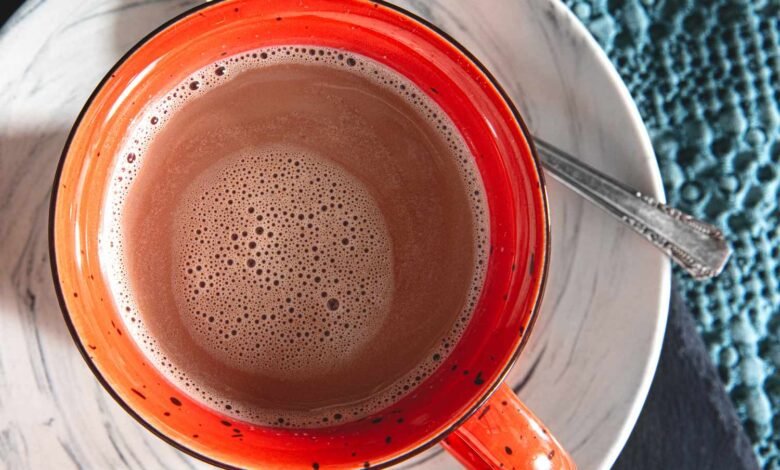

Why It Works
- Malted milk powder gives the hot chocolate a toasty nuttiness and lends additional creaminess to the drink.
- Seasoning the beverage with a pinch of salt highlights the chocolate and malted milk powder’s complex, earthy flavors.
Nothing—except for maybe my antidepressants and vitamin D supplements—lifts my spirit the way hot chocolate does. It’s warm and comforting, a beacon of light during the dark days of winter. Peek into the windows of my apartment on a cold wintry evening, and you’ll likely find me curled up on the couch with a sizable mug of hot chocolate, pretending I’m sitting by a fire inside a Swiss chalet.
My wintertime hot chocolate habit started a few years ago on a cold day when I had an undeniable urge to make a favorite drink from my childhood: Horlicks, a malted milk beverage popular in Hong Kong and the United Kingdom. Though Horlicks is often used as a sleep aid in Britain, it’s served at all hours of the day in Hong Kong, where it’s a popular drink at cha chaan tengs—Hong Kong-style diners—and available both hot and cold. As I whisked the Horlicks powder into a pot of simmering milk, I couldn’t help but think about how delicious the drink would be if I just added a few chunks of dark chocolate. It would, essentially, become a malted hot chocolate.
That’s precisely what I did. And over the years, I’ve developed a very specific method for making the drink exactly the way I like it. I’ve experimented with different types of milks, chocolates of various percentages, and switched up the amount of malted milk powder until I arrived at my ideal version: a hot chocolate that has the fruity, bittersweet flavor of dark chocolate and a rich nuttiness from three tablespoons of Horlicks. A pinch of salt highlights the complexities of both the chocolate and malted milk powder, helping to bring it all together for a balanced drink.
My malted hot chocolate is not as thick as the drinking chocolate you might find at a Parisian café or a chocolatier, but it’s not as thin as chocolate milk, either. As with coffee, people tend to have pretty strong personal preferences about their hot chocolate. So you can use my formula below as a jumping-off point for creating your perfect cup. Want it a bit richer? Consider replacing 1/4 cup of the whole milk with heavy cream. Want it to be thicker and more cocoa-forward? Add an extra ounce or two of chocolate. Love that malty flavor? You can bump up the malt powder even more (or cut it down if you prefer it less malty). And if you’d like it on the sweeter side, consider using milk chocolate or adding a teaspoon or two of sugar.
Through my tweaking over the years, I’ve come to the conclusion that you don’t need a million ingredients to make great hot chocolate: just good-quality chocolate used in the right proportion to the milk for a deeply flavorful beverage. You’ll notice there’s no cocoa powder here, and that’s no mistake. While unsweetened cocoa powder can give beverages and baked goods a deeper chocolate-y flavor, it often requires additional sugar to balance out its bitterness. Plus, it incorporates best when sifted—a fussy step that I can’t be bothered with when all I want is a quick cup of hot chocolate.
Serious Eats / Amanda Suarez
A Dash of Malt
Made from a mixture of dehydrated milk, malted barley, and wheat flour, Horlicks gives beverages and desserts a toasty, earthy flavor. Its unique taste is the result of malting, the process of drying, sprouting, and toasting grains, which transforms the grain’s starches into more complex sugars and its proteins into amino acids. Often used in the beer brewing and whiskey distilling process, malted grains also feature in my favorite candy—Maltesers—and lend other powdered beverages like Ovaltine and Milo their flavor. Malt powder is also what gives a malted milkshake its signature flavor.
Many bakers, including former Serious Eats editor Stella Parks, use malted milk powder to give their baked goods a savory depth. Stella calls the ingredient “the umami bomb of desserts,” as it has a satisfying “roasted, toasted, earthy flavor,” a pleasant creaminess from the powdered milk, and a touch of salt that rounds everything out. Adding several spoonfuls of malted milk powder is an effortless way of making desserts and beverages taste a bit more complex, and it’s how I give my hot chocolate oomph. (Don’t confuse malted milk powder with diastatic malt powder, which has an active enzyme, amylase, and is frequently used to help yeast develop in doughs.) For this recipe, you can use Horlicks or any other malted milk powder.
Does the Chocolate Matter?
My general policy is that any chocolate I bake with should be good enough to eat on its own. This is especially important in something like hot chocolate, as it’s the main ingredient in the beverage, and so the quality of your chocolate will greatly impact how your hot chocolate tastes. With that said, you certainly don’t have to use expensive or fancy chocolate here. As Stella wrote in her chocolate chip taste test, the standard of chocolate available in grocery stores has significantly improved over the years, and most stores will carry an assortment of single origin or highquality chocolates that will work well here.
I’ll be the first to admit I have a bit of a chocolate problem: I purchase my chocolate in three kilogram bags (about six and a half pounds) from Valrhona, which, based on how much I bake, is the most delicious and cost-effective option. It’s the same chocolate I used as a professional pastry cook, and it remains my go-to chocolate for eating and baking. I usually go for Valrhona’s Guanaja 70% or the Manjari 64%, versatile dark chocolates with warm, fruity notes that I use in mousse, cookies, and yes, my hot chocolate.
Choose your favorite dark chocolate bar, block, feves, or chips, and you’ll be fine. (Note that because chocolate chips often contain stabilizers, which help them keep their shape during baking, they may take slightly longer to melt if you choose to use them in your hot chocolate.)
Why dark chocolate? I find milk chocolate too sweet to be enjoyable in a hot chocolate (especially if you’re topping it with mini marshmallows) and prefer the bittersweet nature of dark chocolate. But if you want a hot chocolate on the sweeter side, feel free to swap out dark chocolate for milk or white chocolate. After all, this is a simple beverage meant to bring you comfort and joy—and something tells me it’s still going to be delicious no matter which route you take. It’s melty chocolate that takes five minutes or less to make. What’s not to love?
Serious Eats / Amanda Suarez
Source link



